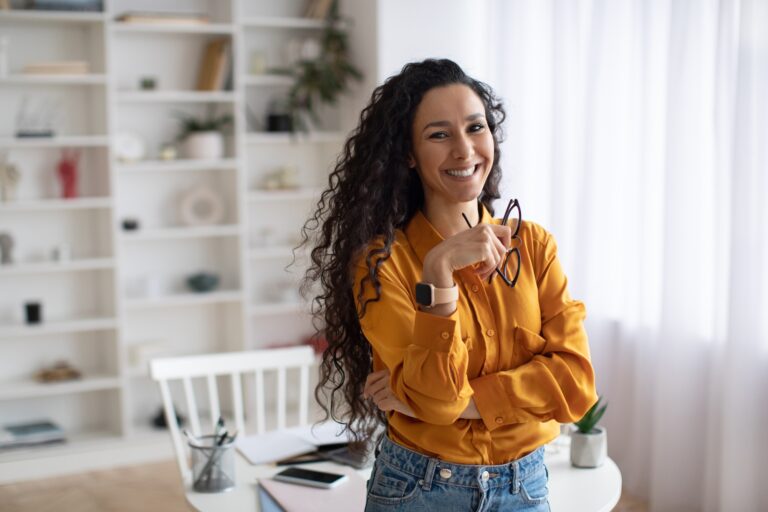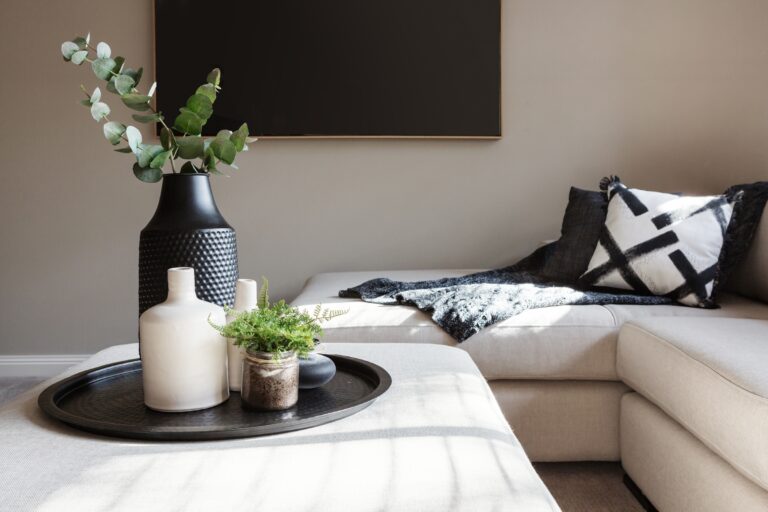Have you ever dreamed of turning your passion for interior design into a flexible career or side gig? Starting a freelance interior design business might be the perfect next step. Whether you’ve worked in design before or you’re pivoting from another path, going the freelance route gives you the flexibility, independence, and creative freedom that in-house design roles can’t always provide.
In this guide, we’ll share seven simple steps to launching a successful freelance interior design business. We’ll talk about what it means to be a freelancer in this field, the key differences between eDesign and full-service work, and how to set up your solo design business.
Table of Contents
Step 1: Ask yourself: What do you want to offer as a freelance interior designer?
One advantage of freelancing is the ability to shape your business solely around the design tasks you love. That said, it’s essential to clearly define the services you offer so clients understand exactly how you can help them..
Here are the most common Service offerings :
- Full-service interior design (expect in-person work, hands-on projects, and seeing a project through from concept to completion)
- eDesign (online interior design, with services and designs delivered virtually)
- Space planning and layout consultations
- Color palettes and paint consultations
- Furniture and decor sourcing
- Moodboards
Your offerings don’t have to stay static—they can evolve as you grow. However, a focused starting point will make it easier to promote your business and connect with the clients you’re best suited to help.
Step 2: Understand the difference between eDesign vs. full-service (and choose which you want to offer)
As a solo interior designer, one of the biggest decisions you’ll make is whether to offer eDesign, full-service design, or a combination of both. Each approach comes with its own set of benefits and challenges—especially when you’re running the business solo.
What Is eDesign?
eDesign is virtual interior design. Everything from the initial consultation to the final product is delivered remotely. You provide clients with mood boards, room layouts, clickable shopping lists, styling instructions, and more. Your clients will manage the installation, ordering, and execution.
Pros of eDesign for freelancers:
- Work from anywhere: All you need is your laptop and Wi-Fi.
- Lower overhead: There are no travel costs, studio rent payments, or in-person meetings.
- Time-efficient: When you remove in-person visits, coordinating with tradespeople, and delivery/installation management, you can finish projects in a fraction of the time.
- Perfect for solo designers: Since everything is done online, you don’t have to manage as many moving parts. This makes the design process easier to handle on your own.
Cons:
- You’re not involved in the install: Clients are responsible for executing the plan, so it may not turn out exactly how you envisioned.
- Less hands-on: Some designers miss the tactile side of in-person work (meeting clients face-to-face, overseeing installation day, and seeing firsthand how their vision comes together in the actual space).
- Not ideal for every client: Some clients can’t handle the execution on their own and may pass on your services in favor of a full-service designer.
What is full-service interior design?
Full-service design involves managing the entire project, from design concept to product sourcing to installation. You’ll work closely with clients, contractors, and vendors throughout the process. You will need to work with local clients or those who live within commuting distance.
Pros for freelancers:
- Larger project budgets: Full-service design takes more time and effort, which often leads to higher pay.
- More creative control: Since you’ll be on-site, you can ensure every detail is executed to plan.
- Stronger client relationships: Working in person builds deeper trust, which may lead to increased referrals.
Cons:
- Time-intensive: You’ll need to accommodate for client meetings, travel, and other logistics.
- Limited to your local area: Even if a client is a great fit stylistically, you might not be able to work with them due to distance.
- Higher responsibility: There’s more to manage, especially if you’re not yet in a position to hire a team.
Step 3: Set your business up for success
It’s easy to get caught up on the creative side, but the back end of your business is equally important. Treating your freelance interior design work like a real company from day one will help you avoid headaches later on.
Here’s what we recommend putting in place right away:
- Choose a business name and register it as an LLC.
- Get a business license or certification if it’s required in your city or state (this is typically only required when working with commercial clients).
- Open a business bank account to separate personal and business finances
- Set up bookkeeping with tools like QuickBooks.
- Look into business insurance, including general and professional liability.
- Create contracts and client agreements to protect both you and your clients.
Step 4: Create clear service packages
Well-structured service packages not only make your offerings easier for clients to understand—they also help streamline your workflow and communicate your value. Thoughtfully packaged services also allow you to price confidently and deliver a consistent, professional experience every time.
Here are some common package examples:
- eDesign Essentials: A virtual design package for one room, including a personalized mood board and a curated shopping list to help you pull the space together on your own.
- eDesign Premium: A more comprehensive virtual design option that includes a detailed room layout, sourcing links for furniture and decor, and follow-up email support to guide you through implementation.
- In-Home Design Consult: A 90-minute in-person visit where we walk through your space, discuss your goals, and provide practical, professional advice you can start using right away.
- Full-Service Design: A completely hands-on experience with a custom design plan, sourcing, project management, and installation, tailored to your space, style, and budget. Pricing varies based on the project scope.
Not sure how to price your packages? DesignFiles lets you build and display design packages directly on your website. From eDesign bundles to in-person consults, you can create clear, bookable offerings that clients can purchase online, making your business look polished and professional from day one.
For eDesign, flat-rate pricing is usually the simplest and most effective. It allows clients to see exactly what they’re getting for a set price, which makes their decision easier and keeps the scope manageable on your end.
For full-service interior design, pricing tends to be more flexible. Many designers charge hourly, a percentage of the total project cost, or offer a custom proposal based on the scope of work. This approach gives you room to account for variables like project size, timeline, and level of involvement.
Step 5: Build a strong online presence
Your online presence is often your first (and sometimes only) chance to make a great impression, especially if you’re offering virtual services. A professional website and active social media profiles help build trust, showcase your style, and communicate your services clearly.
Think of your digital presence as your virtual storefront—it should reflect who you are as a designer and make it easy for potential clients to say, “Yes, I want to work with them.”
We recommend including these details on your website:
- A portfolio (even if it starts with mock projects or personal spaces)
- A clear list of your services and packages
- A warm and professional “About” page
- An easy way for people to contact you
- Testimonials (even if they’re from friends or family)
Beyond your website, consider building your presence on platforms like:
- Thumbtack
Step 6: Find your first freelance clients
Your first freelance client is often the hardest to secure. Here are some ways to make it easier to land your first few clients as a freelance designer:
- Start with your network: Let friends, family, and past coworkers know what you’re offering. Someone in your circle may be in need of your services.
- Offer a launch discount: Offer limited-time pricing for early clients in exchange for their testimonials.
- Reach out to realtors or home stagers: These professionals often need design support but may not have the time to source it themselves.
- Be active in Facebook groups or local forums: Consistently offering helpful advice and thoughtful insights builds credibility and trust, even if you’re still establishing your professional design experience.
- Use social media to show what you can do: Share before-and-after transformations, design tips, and reels that reflect the business you’re building, not just where you’re at right now.
Step 7: Streamline your workflow
Time management is critical for freelance interior design businesses. You have no choice but to be the designer, the project manager, the marketer, and the bookkeeper. We recommend investing in reliable tools and software that help streamline your workflow and keep your business running smoothly.
Here are some types of tools you’ll want to consider from the start:
- Design tools
- Project management software
- Client communication portals
- File sharing software
- Scheduling tools
- Invoicing and payment software
Dreading the multi-tasking? DesignFiles is an all-in-one interior design business software that simplifies your workflow, so you don’t have to rely on separate apps for different tasks. With features like built-in questionnaires, product sourcing, moodboard creation, client communication tools, and invoicing all in one place, DesignFiles helps freelancers stay organized without juggling five different platforms. It’s ideal for solo designers who want to save time and deliver a top-tier client experience.
Whether you’re building a flexible eDesign business you can run from anywhere, or crafting beautiful spaces through full-service work, freelancing can provide you with:
- Creative freedom
- Location freedom
- Schedule flexibility
- Business ownership
This combination allows you to design not just beautiful spaces, but also a lifestyle that fits your personal and professional goals.
One last note: Be sure to follow along with DesignFiles as you get started with freelancing. We’re regularly creating tools and resources like these to help designers of all levels thrive:
- How to Start an Interior Design Business with No Experience
- How to Run an Interior Design Business
- How to Start an eDesign Business
Starting your freelance interior design business is a bold and exciting move, and the right tools can make all the difference. DesignFiles gives you everything you need to build, manage, and grow your business from day one.
Try it free today and see how easy it can be to run your design business with confidence and professionalism.


